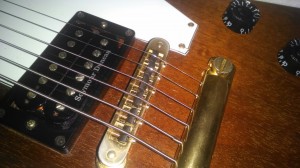It’s very unfortunate, but the Hell & Heaven festival set for this weekend has been cancelled. Pro-fé-cia is currently planning more shows throughout Mexico to make up for it. Stay tuned for details.
Author: LukeSniper
New saddles from GraphTech

Thanks to Joe over at GraphTech for sending over these new StringSaver graphite saddles.
I’ve known about StringSavers for Fender instruments for a long time, but only recently discovered that they make them for TOM bridges as well! The thick unwound strings I use were cutting into my old saddles, and it was causing some problems. These should do much better.
Music Speed Changer Pro
Finally! There are lots of apps out there that can slow down or change the pitch of an audio file, but I’ve had a hell of a time finding one that can actually save the altered file. This Android app does it! As a teacher, I often provide my students with slower or pitch-shifted versions of tunes to practice. Previously, I had to give them a web address, then tell them to check it the next day after I’d gone home and edited whatever song they were working on. Now I can alter the song during the lesson and upload it before they even leave!
Very happy with this app. https://play.google.com/store/apps/details?id=com.teapps.musicspeedchanger
Reviewing some Shubb stuff
So I got a big box of goodies from Shubb last week, and I wanted to post my thoughts on all their non-capo products. These are my thoughts after just a day or two. I don’t know what the deal is with the camera (I think it’s a shielding issue). I wanted to try to record it again, but I don’t have another camera available and it kept on doing that.
Shubb capos
I just got off the phone a few minutes ago, and I’m very excited to announce that I’ve joined the Shubb Capo Company artist family!
Anyone who has played with me has probably seen me using their capos. I’ve probably also given you my spiel about why I find them so superior to others on the market, but it’s all true. I’ve never bought any other capo. I’ve tried nearly every brand out there, but Shubb has remained the best in my mind ever since my guitar teacher first showed them to me nearly 15 years ago. I bought two of them back then (one for classical and one for electric) and have never needed another since.
They’ve made a few improvements to the design since then. I’ve been using the capo noir model on a daily basis for a couple weeks now, and it’s awesome. I’m anxious to try out the other models and products that are on their way. Check back here for my thoughts.
Vexflow
This is pretty sweet!
This guy wrote a music engraving tool in javascript. The tablature below was rendered entirely in your browser!
Creating images for little snippets of tablature or notation is a pain. It can also result in a less-than-uniform look. I used to use the ScoreRender plugin for WordPress, but it’s no longer supported. I’ve finally found an alternative!
Upcoming shows
Updates to the site
I’ve spent some time updating the site recently.
New additions include:
- links to my YouTube and Facebook pages (to the left)
- an interactive slideshow (click “Gallery” up top)
- updated résumé and contact info (also up top)
- that kick ass banner
- …and a bunch of other little things
I’ll be making some more updates soon. I’ve got some plans for some great content (primarily video), but I need to set up a good space to shoot.
A few videos…
Just a couple performance vids…
Satriani’s Warmup
I won’t deny it, I stole this from a Joe Satriani video. It’s a tough video to find though, and it’s a great exercise, so I feel obligated to pass it along. I do this practically every day, especially before shows or any extended practice session. Apparently Satch does it every day too, so that’s enough reason for me to do the same. It does a great job of loosening up the muscles in your hand and getting you ready to play.
The whole thing is basically these two shapes:

Play those two shapes as written, it doesn’t matter what fret, but preferably a low one because you need somewhere to go. Next, move them up one string. Don’t worry about maintaining the intervals, just keep the shape. Now move up another string and do it again. Now you should be on the four top strings, so your next step is to move up a fret and do the shapes again. Now move down a string, do it again, down another string, do it again, up a fret, do it again…. you get the point.
It’s most helpful if you do this to a metronome, especially when you really start building up speed. But the important thing to pay attention to throughout is that every note is clear and you have no extraneous noises.
This next part is a simple little alteration to the last idea. This time, instead of moving that shape around, we’re going to use diminished 7th chords. I do this with drop 2 voicings, but you can do it with any type of chord that covers four adjacent strings. Here are the shapes I use:

Notice that they’re moving up in string sets just like we did in the last exercise. Do the same pattern of moving across the strings and up one fret as before. This one is a bit more challenging, but more applicable in real music situations. For example, if you had an A7 chord, you could do these three shapes on the 6th fret low E string (Bb), then the 7th fret A string (E), then the 8th fret D string (Bb again) and get a really cool b9 thing going during that chord.
Check out the video for some other ideas on how to alter this exercise to keep it fresh and challenging.



